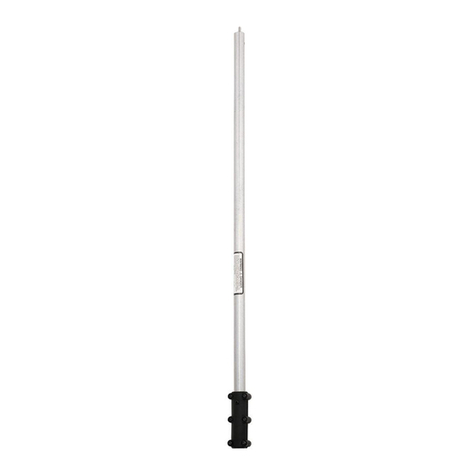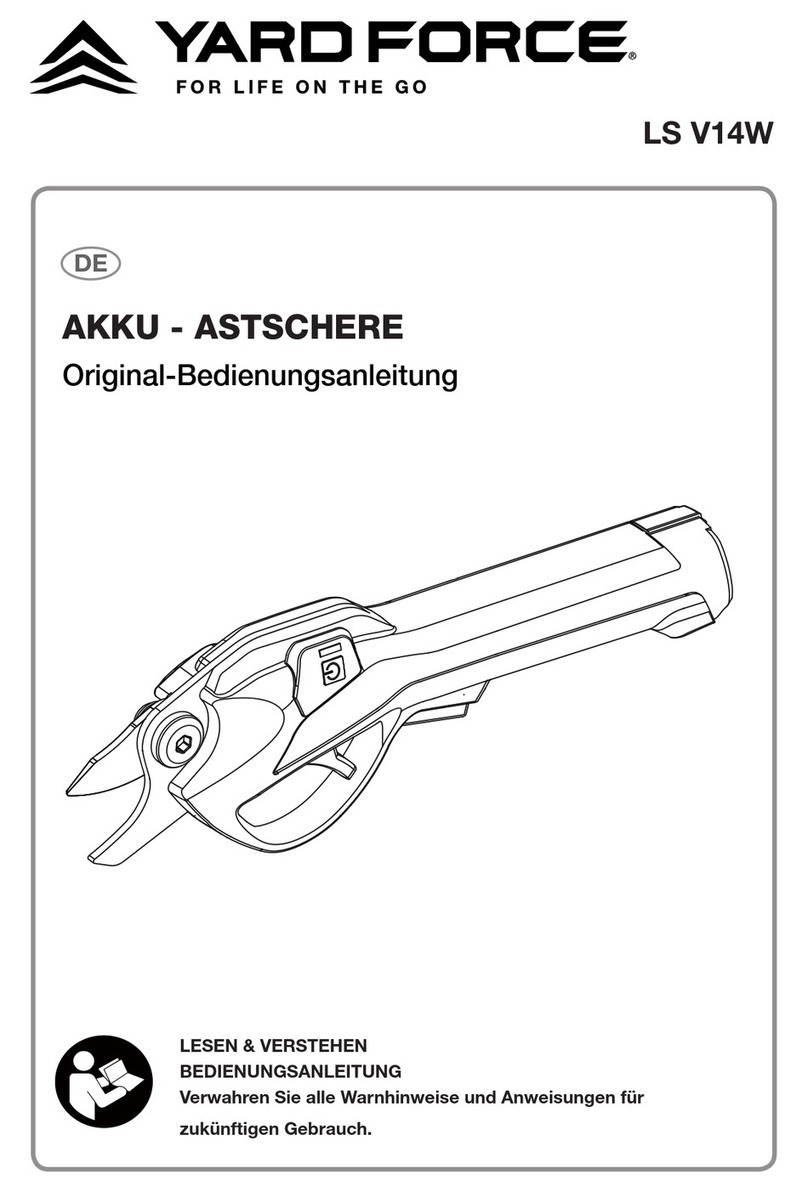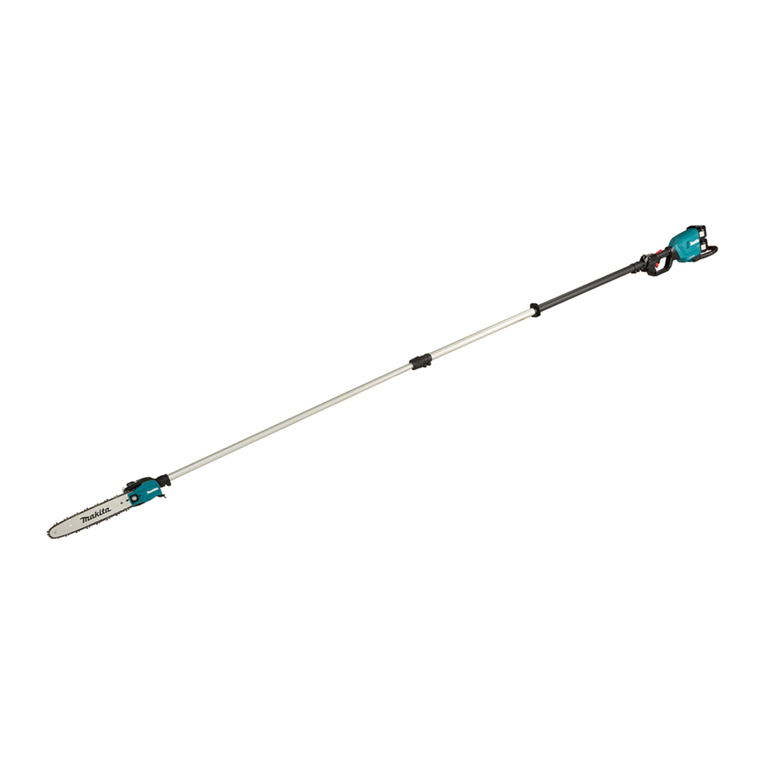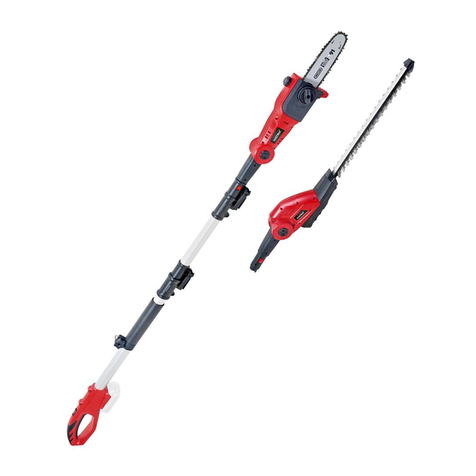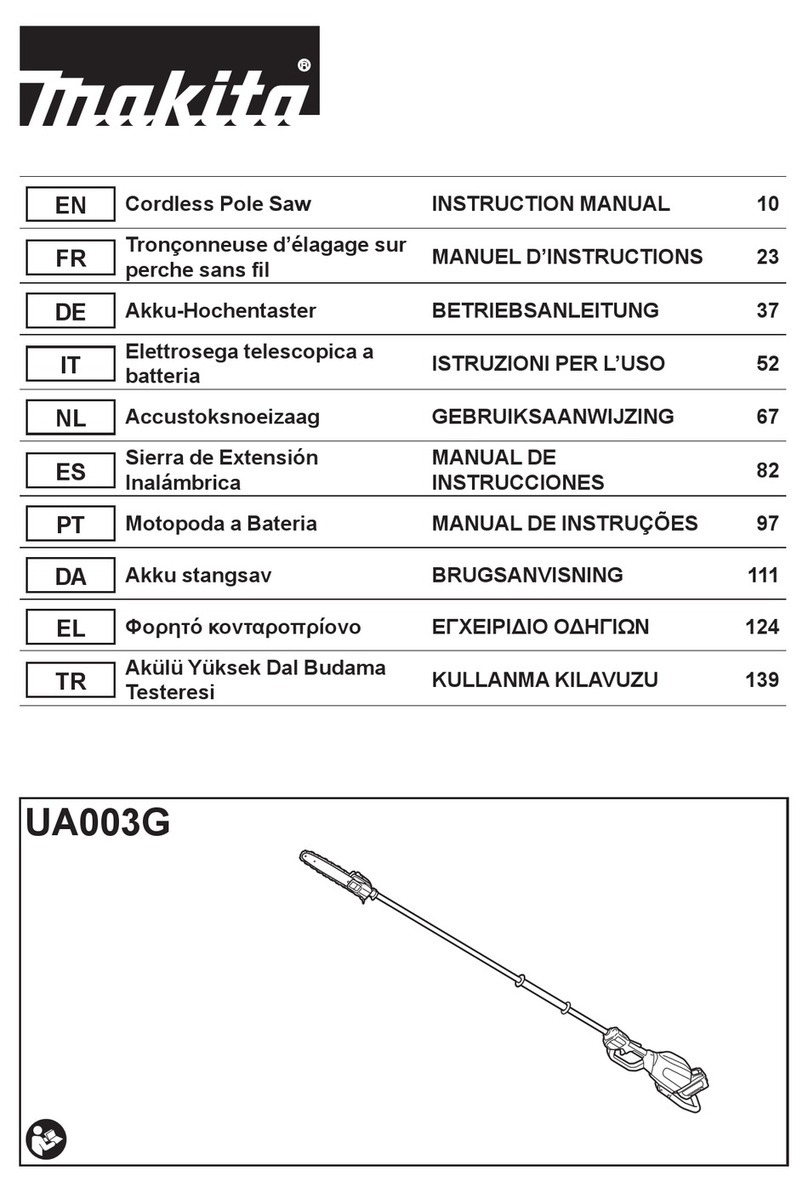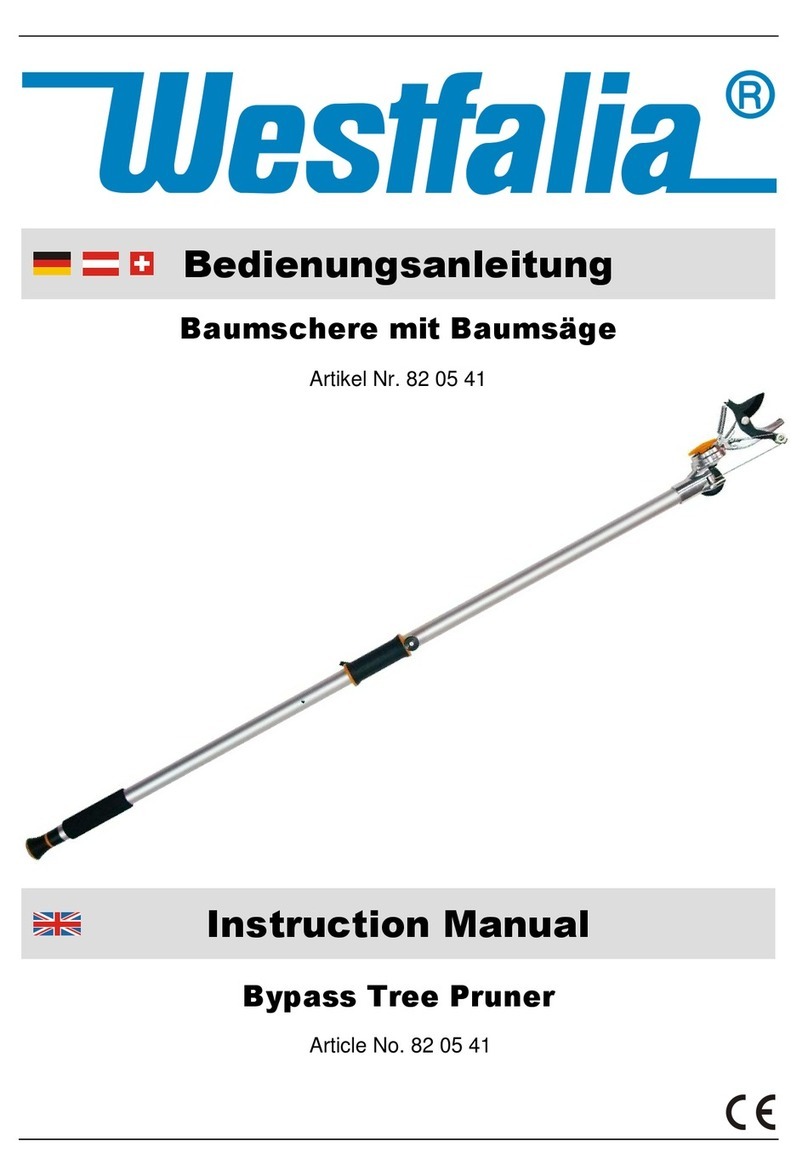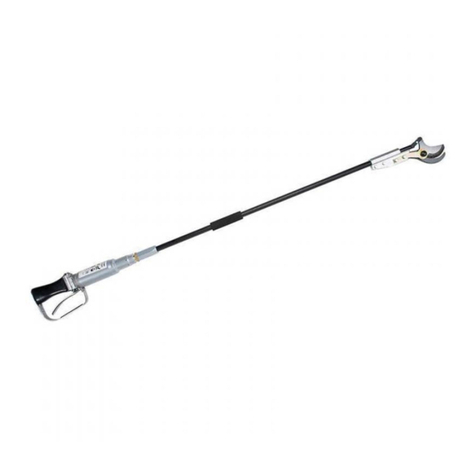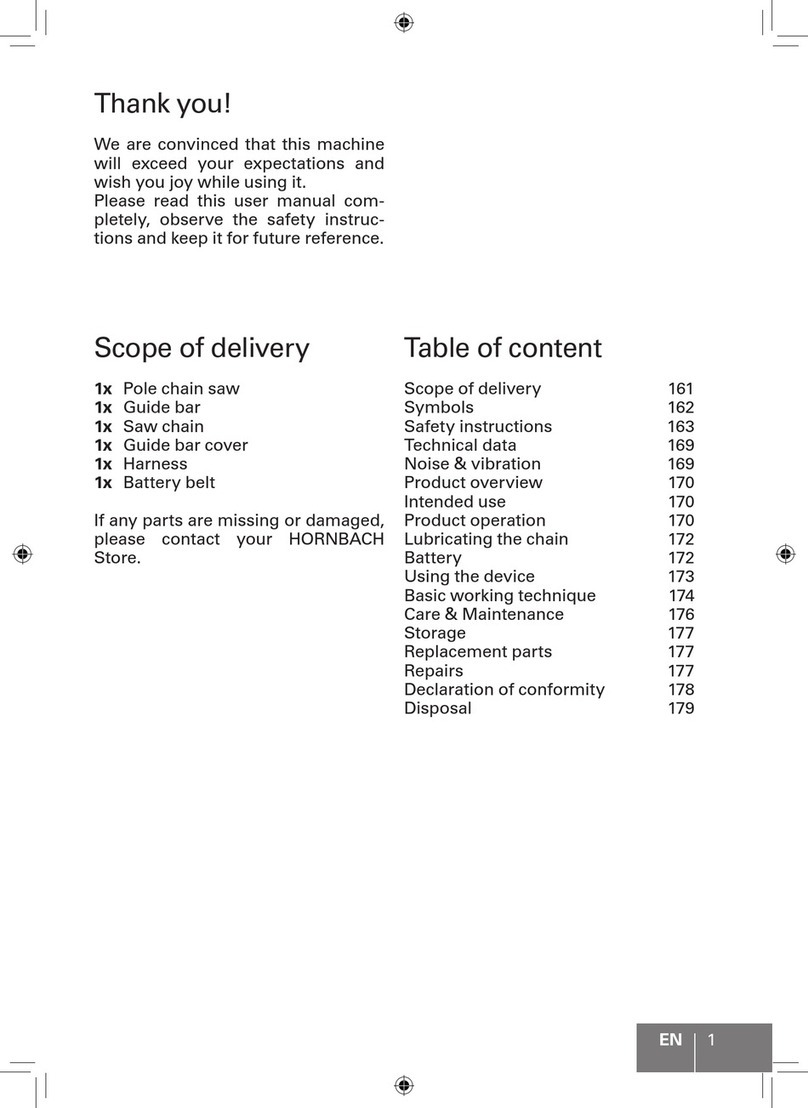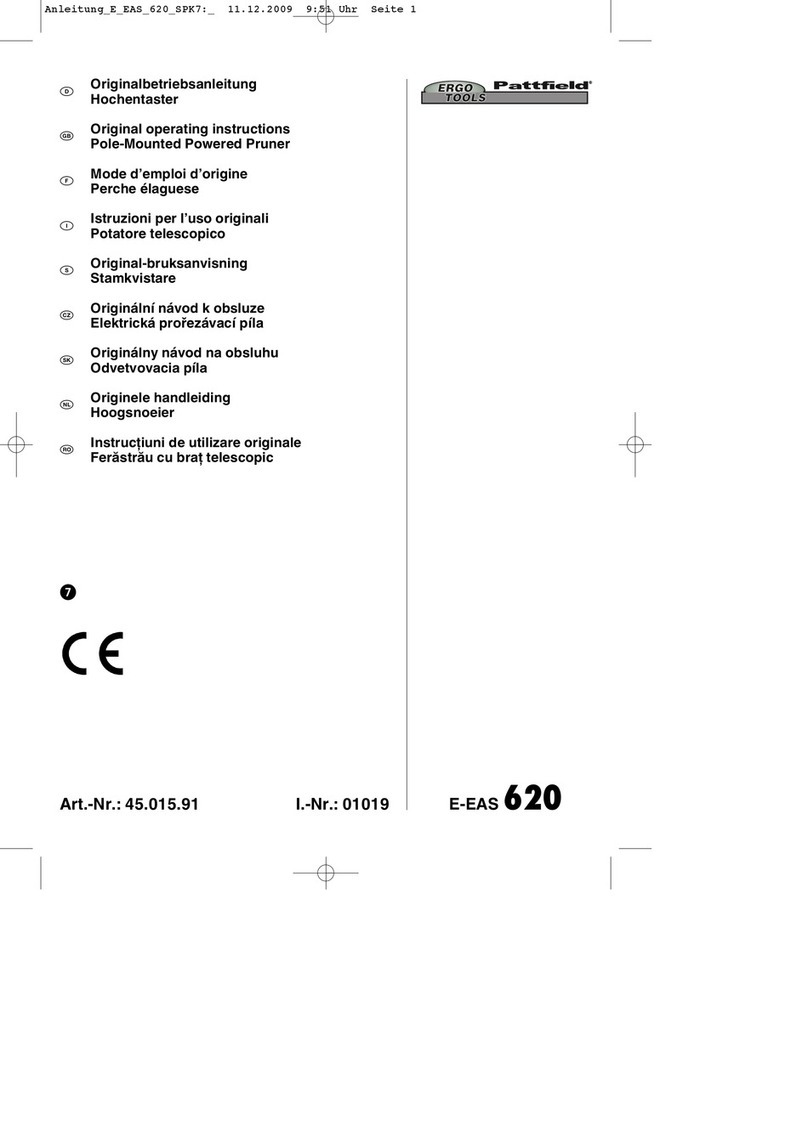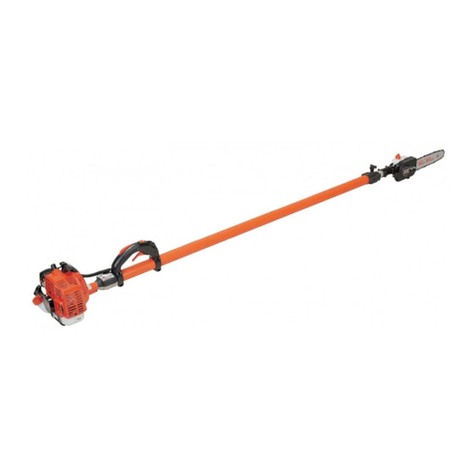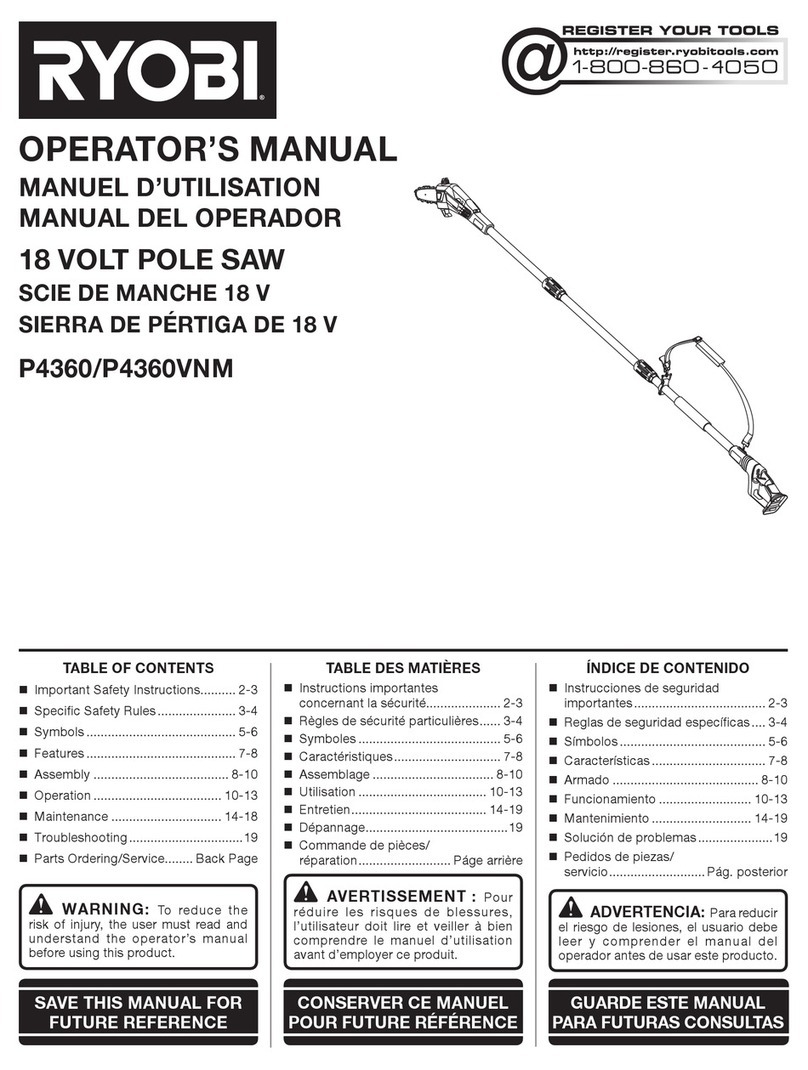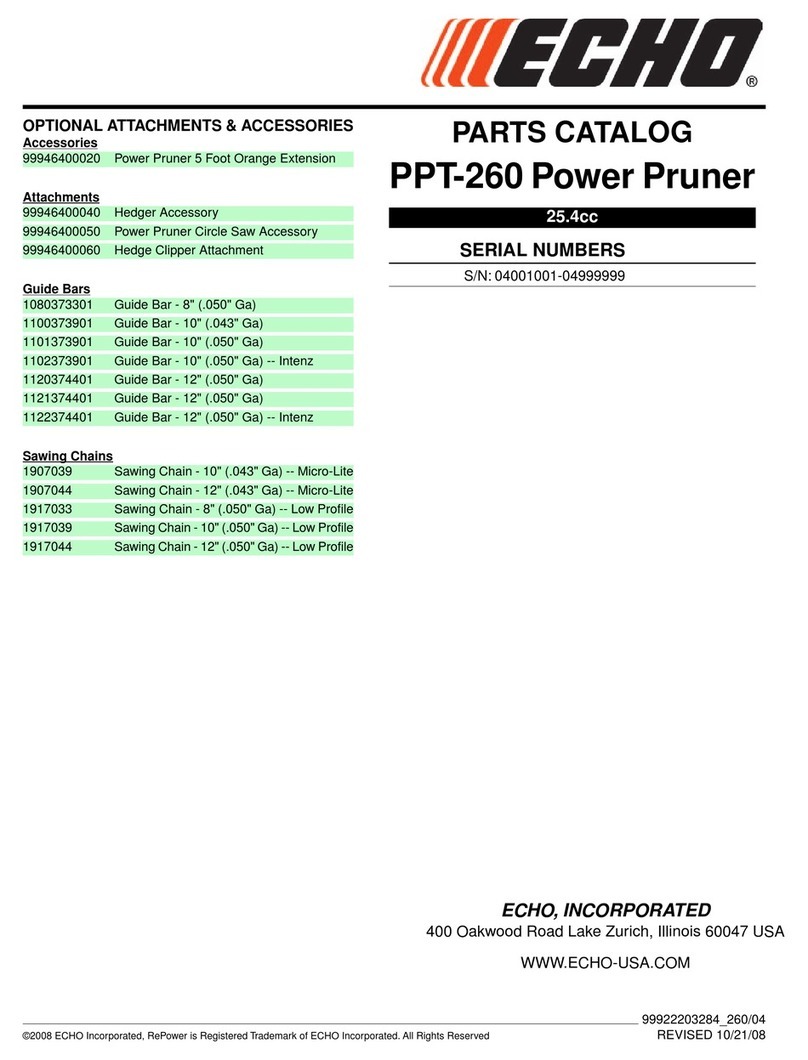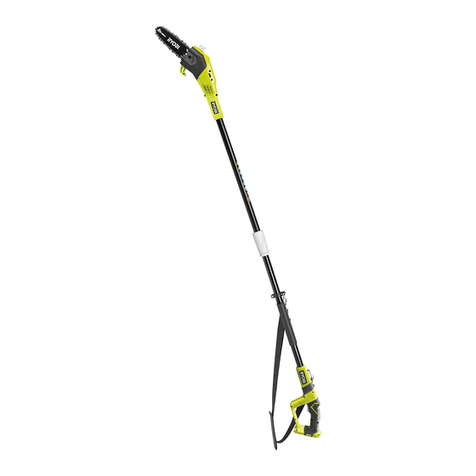SNOWJOE SUNJOE 24V-PRN1- LTE User manual

Original instructions.
© 2022 Snow Joe, LLC. All rights reserved.
A Division of Snow Joe, LLC Model 24V-
PRN1-
LTE Form No. SJ-24V-PRN1-LTE-880E-M
R
OPERATOR’S MANUAL
1
EN
CORDLESS HANDHELD PRUNER
24V MAX*
| COMPATIBLE WITH 24V-
PRN1XP
*Initial no-load voltage, when fully charged, peaks at 24
volts; nominal voltage under typical load is 21.6 volts.
SAVE THESE INSTRUCTIONS
IMPORTANT!
Safety Instructions
All Operators Must Read These
Instructions Before Use
Read all safety warnings and instructions. Failure to follow the
warnings and instructions may result in electric shock, re and/
or serious injury.
General Safety
Notice the personal safety alert symbol mused in this manual
to draw your attention to a WARNING given along with the
particular operating instruction. This means that the operation
requires special ATTENTION, CAUTION, and AWARENESS.
When using this power tool, basic safety precautions, including
the following, should always be followed to reduce the risk of
re, electric shock, personal injury and material damage.
mWARNING! This tool is not intended for use by children
or by unassisted, unsupervised persons whose physical,
sensory or mental capabilities prevent them from using it
safely. Children should be supervised to ensure that they do
not play with the tool.
mWARNING! The cutting blades are sharp. Keep hands
and feet away from the blades and the cutting area.
Personal Safety
• Stay alert – Watch what you are doing and use common
sense. Do not use the power tool while you are tired
or under the influence of drugs, alcohol or medication.
Careless or improper use may lead to serious injury.
• Avoid unintentional starting – Ensure the switch is in the
off position before inserting the battery, or before picking
up or carrying the tool. Carrying power tools with your
finger on the switch may lead to accidents.
• Use personal protective equipment – Always wear eye
protection, non-skid safety shoes and a hard hat to reduce
the risk of personal injury.
• Do not overreach – Keep proper footing and balance at
all times. This enables better control of the power tool in
unexpected situations. Always use two hands if operating
in pole pruner mode. Hold the pole pruner with both
hands to avoid loss of control.
• Remove any adjusting key or wrench before turning
the power tool on – A wrench or a key left attached to
a rotating part of the power tool may result in personal
injury.
• Dress properly – Do not wear loose clothing or jewelry
as such articles can become caught in moving parts. Tie
up long hair. Using work gloves and protective footwear is
recommended when working outdoors.
• Sharp blades – Keep all parts of the body away from the
blades. Do not grasp the exposed blades when picking up
or holding the tool. When transporting or storing the tool,
always fit the blade sheath on. Do not remove cut material
or hold material to be cut when blades are moving. Make
sure the switch is off when clearing jammed material. A
moment of inattention while operating the product may
result in serious personal injury.
• Avoid body contact with the earthed or grounded
surfaces, such as pipes, radiators, ranges or
refrigerators – If the body is earthed or grounded, the risk
of electric shock will increase.
Power Tool Use and Care
• Know your tool – Make sure you know how to switch the
tool off in an emergency. Be thoroughly familiar with the
controls and ensure they are functioning properly. Do not
use the power tool if the switch does not turn it on and off.
• Use the right tool – Use the power tool and accessories
in accordance with these instructions and in the manner
intended for the particular use of the power tool, taking
into account the working conditions and the work to be
performed.
• Do not force the pruner – It will do the job better with
less likelihood of injury if it is used at the rate for which it
was designed.
• Disconnect the battery pack from the tool before
making any adjustments, changing accessories
or storing the power tool – Such preventative safety
measures reduce the risk of starting the power tool
accidentally.
• Store indoors – When not in use, the tool should be
stored indoors in a dry place inaccessible by children.
• Maintain tool with care – Check for misalignment or
binding of moving parts, breakage of parts and any other
condition that may affect the power tool’s operation. If
damaged, have the power tool repaired before use. Many
accidents are caused by poorly maintained power tools.

2
• Keep cutting blades sharp and clean – Properly
maintained cutting blades with sharp edges are less likely
to bind and are easier to control.
• If your power tool requires service, contact an authorized
Snow Joe®+ Sun Joe®dealer or call the Snow Joe®+
Sun Joe®customer service center at 1-866-SNOWJOE
(1-866-766-9563). Only identical replacement parts should
be utilized for repairs. This will ensure that the safety of
the power tool is maintained.
Work Area Safety
mWARNING! Do not operate near power lines. Consult
local regulations for safe distances from overhead power lines
and ensure that the work area is safe before operating the
pruner.
• Keep work area clean and well lit – Cluttered and dark
areas invite accidents.
• Avoid dangerous environments – Do not operate the
tool in gaseous or explosive environments or use it near
flammable or combustible materials.
• Bad weather – Do not use the pruner in bad weather
conditions, especially when there is a risk of lightning.
Doing so decreases the risk of being struck by lightning.
• Keep bystanders and children away – All bystanders,
including children and pets, should be kept a safe
distance away from the work area.
• Do not expose the tool to rain or wet conditions –
Contact with water will increase the risk of electric shock.
Battery & Charger
Safety Instructions
We pay a great deal of attention to the design of every battery
pack to ensure that we supply you with batteries that are safe,
durable and have a high energy density. The battery cells have
a wide range of safety devices. Each individual cell is initially
formatted and its electrical characteristic curves are recorded.
This data is then used exclusively to be able to assemble the
best possible battery packs.
Despite all the safety precautions, caution must always be
exercised when handling batteries. The following points must
be obeyed at all times to ensure safe use. Safe use can only
be guaranteed if undamaged cells are used. Incorrect handling
of the battery pack can cause cell damage.
IMPORTANT! Analyses conrm that incorrect use and poor
care of high-performance batteries are the main factors
responsible for personal and/or product damage.
mWARNING! Do not use a battery pack or tool that is
damaged or modified. Damaged or modified batteries may
exhibit unpredictable behavior resulting in fire, explosion or risk
of injury.
Have your battery pack serviced by a qualied repair person
using only identical replacement parts. This will ensure that the
safety of the battery pack is maintained.
mCAUTION! To reduce the risk of injury, use only official
24V iON+ designated chargers and 24V iON+ battery packs.
The use of other batteries or chargers poses a risk of re,
personal injury or damage. Do not modify or attempt to
repair the tool or the battery pack except as indicated in the
instructions for use and care. Do not wire a battery pack to a
power supply plug or car cigarette lighter. Such misuse will
permanently disable or damage the battery pack.
mWARNING! To reduce the risk of electric shock,
always unplug the charger before performing any cleaning
or maintenance. Do not allow water to flow into the charger.
Use a Ground Fault Circuit Interrupter (GFCI) to reduce shock
hazards.
• Avoid dangerous environments – Do not charge the
battery pack in rain, snow or in damp or wet locations.
Do not use the battery pack or charger in the presence
of explosive atmospheres (gaseous fumes, dust or
flammable materials) because sparks may be generated
when inserting or removing the battery pack, which could
lead to a fire.
• Charge in a well-ventilated area – Do not block the
charger vents. Keep them clear to allow for proper
ventilation. Do not allow smoking or open flames near a
charging battery pack. Vented gases may explode.
NOTE: The safe temperature range for the battery is 41°F
(5°C) to 105°F (40.5°C). Do not charge the battery outside
in freezing weather; charge it at room temperature.
• Maintain charger cord – When unplugging the charger,
pull the plug, not the cord, from the receptacle to reduce
the risk of damage to the electrical plug and cord. Never
carry the charger by its cord or yank it by the cord to
disconnect it from the receptacle. Keep the cord away
from heat, oil and sharp edges. Make sure the cord will
not be stepped on, tripped over or subjected to damage
or stress when the charger is in use. Do not use the
charger with a damaged cord or plug. Replace a damaged
charger immediately.
• Do not use an extension cord unless it is absolutely
necessary – Using the wrong, damaged or improperly
wired extension cord poses a risk of fire and electric
shock. If an extension cord must be used, plug the
charger into a properly wired 16 gauge or larger extension
cord with the female plug matching the male plug on the
charger. Make sure that the extension cord is in good
electrical condition.
• Do not expose the tool or battery pack to fire –
Exposure to fire or temperatures above 265°F (130°C) may
cause the battery pack to explode, causing personal injury
or damage. Toxic fumes and materials are created when
battery packs are ignited.
• Use only recommended attachments – Use of an
unapproved attachment may result in risk of fire, electric
shock or personal injury.

3
• Do not crush, drop or damage battery pack – Do not
use the battery pack or charger if they have sustained
a sharp blow, been dropped, run over or have been
damaged in any way (i.e. pierced with a nail, hit with a
hammer, stepped on, etc.).
• Do not disassemble – Incorrect reassembly may pose
a serious risk of electric shock, fire or exposure to toxic
battery chemicals. If the battery or charger is damaged,
contact an authorized Snow Joe®+ Sun Joe®dealer or
call the Snow Joe®+ Sun Joe®customer service center at
1-866-SNOWJOE (1-866-766-9563) for assistance.
• Battery chemicals cause serious burns – Never let a
damaged battery pack contact the skin, eyes or mouth.
If damaged, battery chemicals will react violently with air.
Use rubber or neoprene gloves to safely dispose of the
battery. If skin is exposed to battery chemicals, wash the
affected area with soap and water. If eyes are exposed
to battery chemicals, immediately flush with water for 20
minutes and seek medical attention. Remove and dispose
of contaminated clothing.
• Risk of short circuit – A battery pack will short circuit if
a metal object makes a connection between the positive
and negative contacts on the battery pack. Do not place a
battery pack near anything that may cause a short circuit,
such as paperclips, coins, keys, screws, nails and other
metallic objects. A short-circuited battery pack poses a
risk of fire and severe personal injury.
• Store your battery pack and charger in a cool, dry
place – Ideally, store the battery pack at 59°F (15°C) and
charged to at least 40%. Do not store the battery pack or
charger where temperatures may exceed 105ºF (40.5ºC),
such as in direct sunlight or inside a vehicle, or where
temperatures may drop below 41°F (5°C).
NOTE: Prevent the battery pack from freezing. Battery
packs that were stored below 32°F (0°C) for more than 60
minutes must be discarded.
• Charge before use – The battery pack supplied with your
tool is only partially charged. The battery pack has to be
fully charged before using the pruner for the first time.
• Battery Aging – Lithium-ion batteries are subject to a
natural aging process. A battery pack must be replaced at
the latest when its capacity falls to just 80% of its capacity
when new. Weakened cells in an aged battery pack are no
longer capable of meeting the high power requirements
needed for the proper operation of your tool, and therefore
pose a safety risk.
• Do not exhaustively discharge the battery pack –
A complete discharge will damage the battery cells. The
most common cause of exhaustive discharge is lengthy
storage. Stop working as soon as the performance of a
battery falls noticeably or the electronic protection system
triggers. For optimum battery performance, charge the
battery pack frequently. Place the battery pack in storage
only after it has been fully charged.
• Do not overload the battery pack – Protect the tool and
battery from overloading. Overloads will quickly result in
overheating and cell damage inside the battery housing
even if it is not apparent externally. For safety reasons,
the integrated protective cutoff will activate to switch off
the equipment. After regular use, allow the battery pack to
cool to room temperature before recharging it.
IMPORTANT! Do not attempt to turn on the tool if the
protective cutoff has been activated. This may damage
the battery pack.
• Outlet voltage – Please check the data marked on the
rating label of the battery charger. Be sure that the voltage
of the power supply matches that marked on the rating
label. Never connect it to a different mains voltage. Never
modify the plug in any way. Do not use any adapter plugs
with grounded tools.
• Charger use – Do not use the supplied battery charger to
charge other types of battery packs or tools.
• Do not overcharge battery packs – Unplug the charger
when not in use. Frequently overcharging the battery pack
will result in cell damage. Do not leave batteries charging
for days on end.
• Battery pack abnormalities – Do not use batteries that
have suffered swelling or deformation or those that exhibit
other atypical symptoms (gassing, hissing, cracking, etc.).
• Electrostatic discharge – When handling batteries, be
wary of electrostatic charge. Electrostatic discharges can
damage the electronic protection system and the battery
cells. To avoid electrostatic discharges, never touch the
battery terminals.

4
Safety Symbols
The following table depicts and describes safety symbols that may appear on this product. Read, understand, and follow all
instructions on the tool before attempting to assemble and operate.
Symbols Descriptions Symbols Descriptions
READ THE OPERATOR'S
MANUAL – Read, understand,
and follow all instructions in the
user manual before attempting
to assemble and operate.
SAFETY ALERT – Indicates a
precaution, a warning, or a danger.
WEAR EYE AND HEARING
PROTECTION – For protection
against injury, wear ear
defenders and safety goggles.
WARNING! Do not expose the tool
to rain or wet conditions. Keep dry.
Wear protective gloves and
non-slip footwear when using
the tool and handling debris.
DANGER! Keep hands
away from blades.
Only use battery charger indoors.
Keep bystanders a minimum
distance of 50 ft (15 m) away
from the work area.

5
Know Your Cordless Handheld Pruner
Read the owner’s manual and safety instructions carefully before operating your cordless handheld pruner. Compare the
illustrations below to the cordless pruner in order to familiarize yourself with the location of the various controls and adjustments.
Save this manual for future reference.
Technical Data
Motor.................................................................................. 80 W
Battery Voltage* Max................................................... 24 V D.C.
Battery Capacity............................................................... 2.0 Ah
Charger Input ........................... 100 - 240V AC | 50/60 Hz | 0.4 A
Charger Output ........................................26 V DC 450 mA
Charge Time Max ........................................................... 5 hours
No Load Speed ............................................................ 16.7 rpm
Cutting Diameter Max .......................................1.02 in. (26 mm)
Cutting Speed ..............................................................1.2 s/cut
Net Weight........................................................... 3.3 lbs (1.5 kg)
*Initial no-load voltage, when fully charged, peaks at 24 volts; nominal voltage under typical load is 21.6 volts.
1. Cutting blade
2. Blade bolt
3. Pruner
4. Hook
5. Removable battery
compartment
6. Battery level indicator
7. Charging socket
8. 24V iON+ lithium-ion battery
charger (XZ2600-0450)
9. 24V iON+ lithium-ion battery
(24VBAT-LTE) featuring exclusive
EcoSharp®technology
10. Connecting lock button
11. Safety lock button
12. Trigger
13. Counter blade
14. Blade sheath
15. Hex key
16. Socket wrench
1 2 3 4 6 7 8
910111213
14
5
15 16

6
Unpacking
Carton Contents
• Pruner
• Removable battery compartment
• Blade cover
• Hex key
• Socket wrench
• iON+ 24V lithium-ion battery
• iON+ 24V lithium-ion battery charger
• Manual with registration card
1. Carefully remove the cordless pruner and check to see
that all of the above items are supplied.
2. Inspect the product carefully to make sure no breakage or
damage occurred during shipping. If you find damaged or
missing parts, DO NOT return the unit to the store. Please
call the Snow Joe®+ Sun Joe®customer service center at
1-866-SNOWJOE (1-866-766-9563).
NOTE: Do not discard the shipping carton and packaging
material until you are ready to use your new cordless
pruner. The packaging is made of recyclable materials.
Properly dispose of these materials in accordance with
local regulations.
IMPORTANT! The equipment and packaging material are not
toys. Do not let children play with plastic bags, foils or small
parts. These items can be swallowed and pose a suocation
risk!
Battery Pack Operation
The equipment is powered by a lithium-ion battery. The battery
pack is completely sealed and maintenance free.
Battery Charge Level Indicator
The battery pack is equipped with a push button for checking
the charge level. Simply press the push button to read o the
battery charge level from the LEDs of the battery indicator:
Lights Light Indicators
Charge level button
The battery is at 30% capacity
The battery is at 60% capacity
The battery is fully charged
NOTE: If the charge level button does not appear to be
working, insert the charger and charge as needed.
NOTE: Immediately after using the battery pack, the charge
level button may display a lower charge than it will if checked
a few minutes later. The battery cells “recover” some of their
charge after resting.
mWARNING! Charge only Sun Joe®24V iON+ lithium-ion
battery pack with its compatible Sun Joe®24V iON+ lithium-
ion charger. Other types of batteries may cause personal injury
and damage.
To reduce the risk of electric shock, do not allow water to ow
into the charger’s AC/DC plug.
Charging the Battery
1. Check that the mains voltage is the same as that marked
on the rating label of the battery charger. Then, plug the
battery charger into an AC power outlet. Insert the charger
plug into the charging socket of the battery to begin
charging (Fig. 1).
2. Remove the battery once fully charged.
mCAUTION! FIRE HAZARD. When disconnecting the
charger from the battery, be sure to unplug the charger from
the outlet first, then disconnect the charger from the battery.
IMPORTANT! Never allow the battery pack to become fully
discharged as this will cause irreversible damage to the
battery.
Assembly
This cordless pruner comes completely assembled with the
blade preinstalled.
mCAUTION! Ensure the battery is not inserted and the
blades are covered by the sheath before assembly.
Fig. 1
LEDs

7
Handheld Pruner Assembly
1. To assemble the tool in handheld pruner mode, slide the
removable battery compartment into the end of the pruner
until it clicks into place (Fig. 2).
2. To disassemble the handheld pruner, press the connecting
lock button and slide the removable battery compartment
out of the pruner.
Pole Pruner Assembly
Telescoping pole sold separately. See the optional accessories
page for more information.
1. To assemble the tool in pole pruner mode, slide the pruner
into the telescoping pole until it clicks into place (Fig. 3).
2. Flip the latch over the hook on the pruner, and press down
to secure the connection (Fig. 4).
Removable battery compartment
Pruner
Connecting lock button
Fig. 2
Cutting head
Telescoping
Pole
Fig. 3
Connecting lock button
Latch
Fig. 4
3. Slide the removable battery compartment into the end of
the pole assembly until it clicks into position (Fig. 5).
4. To disassemble, press the connecting lock button and
slide the removable battery compartment out of the
telescoping pole.
5. Flip the latch up to unlock the pruner. Then press the
connecting lock button and slide the pruner out of the
telescoping pole (Figs. 6
-
7).
Fig. 5
Removable battery
compartment
Fig. 6
Latch lock
Fig. 7
Connecting lock button

8
Operation
IMPORTANT! The product is intended for light pruning of
shrubs and hedges of residential properties.
mWARNING! The blades continue to move after releasing
the trigger. Turn off the tool and wait until the blades come to a
complete stop before adjusting or cleaning.
mCAUTION! Wear protective gloves while working
with the pruner. Never touch the blades while the tool is in
operation and be aware of the sharp edges even when the
pruner is not in use.
Handheld Pruner Operation
1. Slide the battery into the removable battery compartment
until it clicks into position (Fig. 8).
2. Grip the pruner with your dominant hand. Squeeze the
safety lock button on the handle to unlock the trigger.
When you are ready to make a cut, pull the trigger to close
the blades. Release the trigger to open the blades (Fig. 9).
Pole Pruner Operation
Telescoping pole sold separately. See the optional accessories
page for more information.
Fig. 8 HANDHELD
PRUNER MODE
Battery
Removable battery
compartment
Fig. 9 HANDHELD
PRUNER MODE
Trigger switch
Safety lock button
mCAUTION! Remove the battery before adjusting the
length or angle of the telescoping pole.
1. Flip up the cam-lock, and extend the pole to the desired
length. Close the cam-lock to secure it in place (Fig. 10).
NOTE: The telescoping pole extends up to 5.83 ft
(1.78 m).
2. To adjust the angle of the pruner in pole pruner mode,
hold down the rotation button and turn the pruner to your
desired angle. Release the button and make sure the
pruner is locked at that angle (Fig. 11-12).
3. Slide the battery into the removable battery compartment
until it clicks into position (Fig. 13).
Fig. 10
Cam-lock Telescoping pole
Fig. 11 Rotation
button
Fig. 12
0°
-22.5°
-45°
22.5°
45°
67.5°
90°

9
4. To use the pole pruner, balance your weight with both feet
on solid ground and hold the pole pruner by one hand on
the rear handle and the other on the pole. Position the
tool at an angle so as to stand away from falling debris
(Fig. 14).
5. Grip the rear handle of the pole and squeeze the safety
lock button to unlock the trigger. When you are ready to
make a cut, pull the trigger to close the blades. Release
the trigger to open the blades (Fig. 15).
Fig. 13 POLE PRUNER MODE
Battery pack
Removable battery
compartment
Fig. 14
POLE PRUNER MODE
Fig. 15 POLE PRUNER MODE
Trigger switch
Safety lock button
Trimming Tips
The pruner can be used to remove fresh blooms, overgrowth,
dead and tangled stems, as well as twigs and weak growth.
1. Never cut too close to the bud, so the wound can heal
properly.
2. Make the cut approximately 0.3 inch (8 mm) above the
bud (Fig. 16).
3. The cut should slope away from the bud, so that rainwater
can be channeled away from it (Fig. 17).
4. When removing the entire stem, cut it back to the point
where it branched (Fig. 18).
Fig. 16
Bud
0.3 inch (8 mm)
Fig. 17
Fig. 18

10
5. Cut branches one at a time (Fig. 19).
Maintenance
mWARNING! Always switch the product off and remove
the battery before performing inspection, maintenance or
cleaning.
mWARNING! Always take extra care when handling the
blades. Always wear protective gloves and keep hands away
from the trigger while sharpening or changing the cutting
blade.
• If the cordless pruner requires cleaning, do not use
solvents to clean it. Only use a moist cloth. Never let any
liquid get inside the tool; and never immerse any part of
the tool in liquid.
• Clean the blades if there is a build up of sap and debris.
Apply lubricant around the blade bolt and open and close
the blades about 10 times to work it in. Use steel wool to
rub the oil over the cutting surfaces. Spray the tool with
alcohol and wipe with a paper towel.
• Inspect the product before each use for worn and
damaged parts. Do not operate it if you find broken and
worn parts.
Blade Maintenance
Only sharpen the cutting blade; the counter blade should never
require sharpening.
1. To sharpen your pruner, file at a 15-degree angle along the
beveled edge of the cutting blade (Fig. 20).
NOTE: Be careful not to sharpen at too steep of an angle,
as this may damage the edge of the blade.
1
2
3
Fig. 19
Fig. 20 Cutting blade
Counter blade
File
2. Move the file only in one direction, with smooth strokes
from the base to the tip.
mCAUTION! Do not over-sharpen. Be sure to test the
blade repeatedly throughout the sharpening process to prevent
over-sharpening.
3. Use the file to remove burrs on the opposite side of the
edge (unbeveled edge).
Blade Replacement
mWARNING! Use only a recommended replacement
blade.
1. Remove the blade cover by unscrewing the two screws
that fix it in place (Fig. 21).
2. To remove the cutting blade, use the included hex key to
remove the nut securing the blade (Fig. 22).
Fig. 21
Blade cover
Screws
Fig. 22
Nut
Hex key

11
3. Use the included socket wrench to remove the blade gear
from the blade bolt. At this point, the blade bolt, cutting
blade and rack should come off the pruner (Figs. 23
-
24).
4. Fit the new cutting blade and the rack on the pruner. Then,
reinstall the blade bolt and blade gear to secure them in
place (Fig. 24).
NOTE: When reinstalling the rack, make sure the gear
teeth are in contact with the pinion.
5. Reattach the blade cover and the two screws.
Storage
• Store the tool in a secure and dry location. The storage
temperature must always remain between 41°F (5°C) to
104°F (40°C).
• Remove the battery from the compartment.
• Clean the product as described above.
• Fit the blade sheath over the blades (Fig. 25).
Fig. 23
Blade
gear
Socket
wrench
Fig. 24 Blade
gear
Cutting bladeRack
Blade bolt
Pinion
• Fully recharge the battery before using the tool after
prolonged storage.
Disposal
• Do not dispose of electrical tools as unsorted municipal
waste. Use separate collection facilities.
• Contact your local government agency for information
regarding the collection systems available.
• If electrical tools are disposed of in landfills or dumps,
hazardous substances can leak into the groundwater and
get into the food chain, damaging your and others’ health
and wellbeing.
Recycling + Disposal
The product comes in a package that protects it against
damage during shipping. Keep the package until you are
sure that all parts have been delivered and the product is
functioning properly. Recycle the package afterwards or keep
it for long-term storage.
WEEE symbol. Waste electrical products should not
be disposed of with household waste. Please recycle
where facilities exist. Check with your local authority
or local store for recycling regulations.
Always dispose of your battery pack according to federal,
state, and local regulations. Contact a recycling agency in your
area for recycling locations.
mCAUTION! Even discharged battery packs contain
some energy. Before disposing, use electrical tape to cover
the terminals to prevent the battery pack from shorting, which
could cause a fire or explosion.
mWARNING! To reduce the risk of injury or explosion,
never burn or incinerate a battery pack even if it is damaged,
dead or completely discharged. When burned, toxic fumes and
materials are emitted into the surrounding atmosphere.
• Batteries vary according to device. Consult your manual
for specific information.
• Install only new batteries of the same type in your product
(where applicable).
Fig. 25
Blade sheath

12
• Failure to insert batteries in the correct polarity, as
indicated in the battery compartment or manual, may
shorten the life of the batteries or cause batteries to leak.
• Do not mix old and new batteries.
• Do not mix Alkaline, Standard (Carbon-Zinc) or
Rechargeable (Nickel Cadmium, Nickel Metal Hydride, or
Lithium-Ion) batteries.
• Do not dispose of batteries in fire.
• Batteries should be recycled or disposed of as per state
and local guidelines.
Service + Support
If your Sun Joe®24V-PRN1-LTE Cordless Handheld Pruner
requires service or maintenance, please call the Snow Joe®+
Sun Joe®customer service center at 1-866-SNOWJOE
(1-866-766-9563).
Model + Serial Numbers
When contacting the company or reordering parts, you will
need to provide the model and serial numbers of your product.
These are found on the decal axed to the housing or handle
of your cordless pruner. Copy these numbers into the space
provided below.
Record the following numbers from the housing or handle of your
new product: Model #:
Serial #:
2
4 V -
P R
N 1 -
L T
E
XZ2600-0450
Federal Communications Commission
(FCC)
mWARNING! Any changes or modifications to this
unit not expressly approved by the party responsible for
compliance could void the user’s authority to operate the
equipment.
This device complies with part 15 of the FCC rules. Operation
is subject to the following two conditions: (1) this device may
not cause harmful interference, and (2) this device must accept
any interference received, including interference that may
cause undesired operation.
Class B device:
NOTE: This equipment has been tested and found to comply
with the limits for a Class B digital device, pursuant to part 15
of the FCC Rules.
These limits are designed to provide reasonable protection
against harmful interference in a residential installation.
This equipment generates, uses and can radiate radio
frequency energy and, if not installed and used in accordance
with the instructions, may cause harmful interference to radio
communications.
However, there is no guarantee that interference will not occur
in a particular installation.
If this equipment does cause harmful interference to radio or
television reception, which can be determined by turning the
equipment o and on, the user is encouraged to try to correct
the interference by one or more of the following measures:
• Reorient or relocate the receiving antenna.
• Increase the separation between the equipment and
receiver.
• Connect the equipment to an outlet on a circuit different
than the one the receiver is currently connected to.
• Consult the dealer or an experienced radio/TV technician
for help.

13
Optional Accessories
mWARNING! ALWAYS use only authorized Snow Joe®+ Sun Joe®replacement parts and accessories. NEVER use
replacement parts or accessories that are not intended for use with this pruner. Contact Snow Joe®+ Sun Joe®if you are
unsure whether it is safe to use a particular replacement part or accessory with your pruner. The use of any other attachment or
accessory can be dangerous and could cause injury or mechanical damage.
Accessories Item Model
24V iON+ 2.0 Ah Lithium-Ion Battery 24VBAT-LTE
24V iON+ 4.0 Ah Lithium-Ion Battery 24VBAT
24V iON+ 5.0 Ah Lithium-Ion Battery 24VBAT-XR
24V iON+ Lithium-Ion Battery Quick Charger 24VCHRG-QC
Cordless Pruner Extension Pole 24V-PRN1XP
Visit sunjoe.com for more options
NOTE: Accessories are subject to change without any obligation on the part of Snow Joe®+ Sun Joe®. Accessories can be
ordered online at sunjoe.com or via phone by contacting the Snow Joe®+ Sun Joe®customer service center at 1-866-SNOWJOE
(1-866-766-9563).
1
2
3
4
5

R4_01282020
SNOW JOE®+ SUN JOE®CUSTOMER PROMISE
OUR WARRANTY:
Snow Joe warrants new, genuine, powered and non-powered Products to be free from defects in material or workmanship when used
for ordinary household use for a period of two years from the date of purchase by the original, end-user purchaser when purchased
from Snow Joe or from one of Snow Joe’s authorized sellers with proof of purchase. Because Snow Joe is unable to control the quality
of its Products sold by unauthorized sellers, unless otherwise prohibited by law, this Warranty does not cover Products purchased from
unauthorized sellers. If your Product does not work or there’s an issue with a specic part that is covered by the terms of this Warranty,
Snow Joe will elect to either (1) send you a free replacement part, (2) replace the Product with a new or comparable product at no charge,
or (3) repair the Product. How cool is that!
This Warranty gives you specific legal rights, and you may also have other rights which vary from State to State.
PRODUCT REGISTRATION:
Snow Joe strongly encourages you to register your Product. You can register online at snowjoe.com/register, or by printing and
mailing in a registration card available online from our website, or calling our Customer Service Department at 1-866-SNOWJOE
(1-866-766-9563), or by e-mailing us at [email protected]. Failure to register your Product will not diminish your warranty rights.
However, registering your Product will allow Snow Joe to better serve you with any of your customer service needs.
WHO CAN SEEK LIMITED WARRANTY COVERAGE:
This Warranty is extended by Snow Joe to the original purchaser and original owner of the Product.
WHAT IS NOT COVERED?
This Warranty does not apply if the Product has been used commercially or for non-household or rental applications. This Warranty also
does not apply if the Product was purchased from an unauthorized seller. This Warranty also does not cover cosmetic changes that do
not aect performance. Wearing parts like belts, augers, chains and tines are not covered under this Warranty, and can be purchased at
snowjoe.com or by calling 1-866-SNOWJOE (1-866-766-9563).
ABOVE ALL ELSE, Snow Joe, LLC (“Snow Joe”) is dedicated to you, our customer. We strive to make your experience as pleasant as
possible. Unfortunately, there are times when a Snow Joe®, Sun Joe®, or Aqua Joe®product (“Product”) does not work or breaks under
normal operating conditions. We think it’s important that you know what you can expect from us. That’s why we have a Limited Warranty
(“Warranty”) for our Products.
14
EN

15


ES
Instrucciones originales.
© 2022 Snow Joe, LLC. Derechos reservados.
*El voltaje inicial sin carga, cuando la batería está cargada por completo, alcanza
un máximo de 24 V. El voltaje nominal bajo una carga típica es de 21.6 V.
GUARDE ESTAS INSTRUCCIONES
17
Una división de Snow Joe, LLC
R
MANUAL DEL OPERADOR
Modelo 24V-
PRN1-
LTE Forma№SJ-24V-PRN1-LTE-880S-M
PODADORA MANUAL
INALÁMBRICA
24 V MAX*. | COMPATIBLE CON 24V-PRN1XP
¡IMPORTANTE!
Instrucciones de seguridad
Todos los operadores deberán leer
estas instrucciones antes del uso
Lea todas las advertencias de seguridad e instrucciones.
No seguir las advertencias e instrucciones puede causar un
choque eléctrico, incendio y/o lesiones personales graves.
Seguridad general
Preste atención al símbolo mde alerta de seguridad
personal usado en este manual para enfocar su atención a
una ADVERTENCIA dada junto a una instrucción de operación
particular. Esto signica que la operación requiere ATENCIÓN,
PRECAUCIÓN y CAUTELA especiales.
Usted debe tomar precauciones básicas de seguridad siempre
que utilice esta herramienta motorizada para reducir riesgos
de incendio, choque eléctrico, lesiones personales y daños
materiales. Dichas precauciones incluyen las siguientes:
m¡ADVERTENCIA! Esta herramienta no ha sido
diseñada para ser usada por niños ni por otras personas sin
asistencia o supervisión cuyas habilidades físicas, sensoriales
o mentales les impidan usarla de forma segura. Los niños
deben estar bajo supervisión para garantizar que no jueguen
con esta herramienta.
m¡ADVERTENCIA! Las cuchillas están afiladas.
Mantenga las manos y los pies lejos de las cuchillas y del área
de corte.
Seguridad personal
• Manténgase alerta: vea lo que está haciendo y use
el sentido común. No utilice la herramienta cuando se
encuentre cansado o bajo la influencia de drogas, alcohol
o medicamentos. Su descuido o uso incorrecto puede
causar graves lesiones personales.
• Evite encendidos accidentales: asegúrese de que
el interruptor esté en la posición de apagado antes
de insertar la batería en la herramienta, levantarla o
transportarla. Transportar herramientas motorizadas con
el dedo sobre el interruptor puede provocar accidentes.
• Use equipos de protección personal: siempre use
protección ocular, zapatos de seguridad anti-deslizantes y
un casco para reducir el riesgo de lesiones personales.
• No se extralimite: mantenga una postura y equilibrio
adecuados en todo momento. Esto permite un mejor
control de la herramienta motorizada en situaciones
inesperadas. Utilice siempre las dos manos si va a operar
esta podadora en modo telescópico. Sujete la podadora
telescópica con ambas manos para evitar la pérdida de
control.
• Retire cualquier destornillador o llave de ajuste
antes de encender esta herramienta motorizada: un
destornillador o llave de ajuste conectado a una parte
giratoria de la herramienta motorizada puede causar
lesiones personales.
• Vístase apropiadamente: no use ropa holgada o joyas ya
que pueden engancharse en las partes móviles. Átese el
cabello largo. Se recomienda el uso de guantes de trabajo
y calzado protector cuando se trabaje en exteriores.
• Cuchillas afiladas: mantenga todas las partes de su
cuerpo alejadas de las cuchillas. Al levantar o sostener
la herramienta, no sujete la herramienta por las cuchillas
expuestas. Al transportar o guardar la herramienta,
siempre colóquele la funda para cuchillas. No retire
material cortado ni sujete el material a ser cortado cuando
las cuchillas estén moviéndose. Asegúrese de que el
interruptor esté apagado al retirar material atascado. Un
momento de distracción durante el uso de este producto
podría ocasionar lesiones personales severas.
• Evite el contacto de su cuerpo con superficies puestas
a tierra tales como tuberías, radiadores, cocinas
eléctricas y refrigeradoras: si el cuerpo está conectado
a tierra, el peligro de un choque eléctrico aumentará.
Uso y cuidado de la herramienta
motorizada
• Conozca su herramienta: asegúrese de saber
cómo apagar la herramienta en caso de emergencia.
Familiarícese a fondo con los controles, y asegúrese de
que funcionen correctamente. No utilice esta herramienta
motorizada si su interruptor no la enciende y apaga.
• Use la herramienta correcta: use la herramienta
motorizada y los accesorios en conformidad con
estas instrucciones y en la manera destinada para el
uso particular de la herramienta motorizada, tomando
en cuenta las condiciones de trabajo y la labor a ser
realizada.
• No fuerce la podadora: hará un mejor trabajo y con
menos probabilidades de lesiones personales si es usada
de la forma para la cual fue diseñada.

18
• Desconecte la batería de la herramienta antes de
realizar en esta última cualquier tarea de ajuste,
cambiarle accesorios, o guardarla: dichas medidas de
seguridad preventiva reducen el riesgo de encender la
herramienta motorizada de forma accidental.
• Guárdela en interiores: cuando no esté siendo usada,
esta herramienta deberá ser guardada en interiores, en un
lugar seco lejos del alcance de los niños.
• Cuide su herramienta: compruebe que no haya partes
rotas, desalineamientos o atascamientos de partes
móviles, o cualquier otra condición que pueda afectar
la operación de esta herramienta motorizada. Si la
herramienta motorizada está dañada, hágala reparar
antes de su uso. Muchos accidentes son causados por
herramientas motorizadas mal mantenidas.
• Mantenga las cuchillas limpias y afiladas: las cuchillas
mantenidas adecuadamente, con bordes afilados, tienen
menos probabilidades de atascarse y son más fáciles de
controlar.
• Si su herramienta motorizada requiere servicio, contacte
a un concesionario autorizado Snow Joe®+ Sun Joe®o
comuníquese con la central de servicio al cliente Snow
Joe®+ Sun Joe®llamando al 1-866-SNOWJOE (1-
866-766-9563). Para las reparaciones se deben utilizar
únicamente partes de repuesto idénticas. Esto mantendrá
la seguridad de la herramienta motorizada.
Seguridad en el área de trabajo
m¡ADVERTENCIA! No la opere cerca de cables de alta
tensión. Consulte los reglamentos locales sobre distancias
seguras a líneas aéreas de alta tensión y asegúrese de que el
área de trabajo sea segura antes de operar la podadora.
• Mantenga el área de trabajo limpia y bien iluminada:
las áreas de trabajo abarrotadas u oscuras pueden
provocar accidentes.
• Evite entornos peligrosos: no opere la herramienta en
atmósferas gaseosas o explosivas, ni la use cerca de
materiales combustibles o inflamables.
• Mal tiempo: no use esta podadora en mal tiempo,
especialmente cuando haya un riesgo de rayos. Hacerlo
reducirá el riesgo de ser fulminado por un rayo.
• Mantenga alejados a los niños y visitantes: todos
los visitantes, incluyendo niños y mascotas, deberán
permanecer alejados a una distancia segura del área de
trabajo.
• No exponga la herramienta a la lluvia o entornos
mojados: el contacto con el agua incrementará el riesgo
de un choque eléctrico.
Instrucciones de seguridad
para la batería y el cargador
Prestamos mucha atención al diseño de cada batería para
garantizar la producción de baterías seguras y durables, con
alta densidad de energía. Las celdas de la batería tienen
varios dispositivos de seguridad. Cada celda individual es
inicialmente formateada y sus curvas eléctricas características
son registradas. Estos datos son luego usados exclusivamente
para ensamblar las mejores baterías posibles.
Independientemente de todas las precauciones de seguridad,
se debe tener mucho cuidado al manipular la batería. Las
siguientes instrucciones deben ser obedecidas en todo
momento para garantizar un uso seguro. Un uso seguro solo
puede ser garantizado si se usan celdas libres de daños. Una
manipulación incorrecta de la batería puede causar daños en
sus celdas.
¡IMPORTANTE! Los análisis han conrmado que el uso
incorrecto y el cuidado deciente de baterías de alto
rendimiento son las causas principales de lesiones personales
y/o daños al producto.
m¡ADVERTENCIA! No use una batería o herramienta
que hayan sido dañadas o modificadas. Las baterías dañadas
o modificadas pueden reaccionar impredeciblemente,
causando un incendio, explosión o lesiones personales.
Su batería deberá ser reparada por una persona calicada
usando únicamente partes de repuesto originales. Esto
mantendrá la seguridad de la batería.
m¡PRECAUCIÓN! Para reducir el riesgo de lesiones,
use solo cargadores originales iON+ de 24 V diseñados para
baterías iON+ de 24 V. El uso de otras baterías o cargadores
representa un riesgo de incendio, daños o lesiones personales.
No modifique ni intente reparar la herramienta o la batería, a
menos que lo haga según lo indicado en las instrucciones de
uso y cuidado. No conecte una batería a un tomacorriente
doméstico ni encendedor de cigarrillos de un vehículo. Dicho
uso indebido dañará o deshabilitará permanentemente la
batería.
m¡ADVERTENCIA! Para reducir el riesgo de un choque
eléctrico, desenchufe siempre el cargador antes de llevar a
cabo cualquier tarea de limpieza o mantenimiento. No permita
que entre agua dentro del cargador. Use un interruptor de
circuito por falla a tierra (GFCI) para reducir el riesgo de un
choque eléctrico.
• Evite entornos peligrosos: no cargue la batería bajo la
lluvia o nieve, ni en lugares húmedos o mojados. No use
la batería ni el cargador en atmósferas explosivas (gases,
polvo o materiales inflamables) ya que al insertar o retirar
la batería se pueden generar chispas que causen un
incendio.

19
• Cargue la batería en un área bien ventilada: no bloquee
los conductos de ventilación de la batería. Manténgalos
despejados para permitir una ventilación adecuada. No
permita que se fume o haya fuego abierto cerca de una
batería siendo cargada. Los gases presentes pueden
explotar.
NOTA:el rango seguro de temperaturas para la batería
es de 41°F (5°C) a 105°F (40°C). No cargue la batería
en exteriores a temperaturas congelantes. Cárguela a
temperatura ambiente en interiores.
• Cuide el cable de alimentación del cargador: al
desenchufar el cargador tire del enchufe, no del cable
de alimentación, para desconectarlo del tomacorriente
y así evitar daños al enchufe y cable. Nunca transporte
el cargador colgado de su cable, ni tire del cable para
desconectarlo del tomacorriente. Mantenga el cable
alejado del calor, grasas y bordes afilados. Asegúrese de
que el cable no sea pisado, que la gente no se tropiece
con éste, ni que esté sujeto a daños o tensiones mientras
el cargador esté siendo usado. No use el cargador con un
cable o enchufe dañado. Reemplace un cargador dañado
inmediatamente.
• No use un cable de extensión a menos que sea
absolutamente necesario: usar un cable de extensión
incorrecto, dañado, o conectado de forma inapropiada
puede causar un incendio o choque eléctrico. Si se
debe usar un cable de extensión, conecte el cargador a
un cable de extensión de calibre 16 (o más grueso) de
alambrado adecuado, con el enchufe macho del cargador
encajando perfectamente en el enchufe hembra del cable
de extensión. Verifique que el cable de extensión esté en
buenas condiciones.
• No exponga la herramienta o su batería al fuego: una
exposición al fuego o a temperaturas por encima de
los 265°F (130°C) puede hacer que la batería explote,
causando lesiones personales o daños. Las baterías
generan sustancias y humos tóxicos al ser quemadas.
• Use solo accesorios recomendados: el uso de un
accesorio no aprobado puede causar un incendio, choque
eléctrico o lesiones personales.
• No triture, deje caer ni dañe la batería: no use la batería
ni el cargador si han sido severamente golpeados, se
han dejado caer, se han aplastado, o han sido dañados
de cualquier forma como por ejemplo perforados con un
clavo, golpeados con un martillo, pisados, etc.
• No desarme la batería ni el cargador:un reensamblado
incorrecto puede presentar un riesgo severo de choque
eléctrico, fuego o exposición a químicos tóxicos de
la batería. Si la batería o el cargador están dañados,
contacte a un concesionario autorizado Snow Joe®+ Sun
Joe®o comuníquese con la central de servicio al cliente
Snow Joe®+ Sun Joe®llamando al 1-866-SNOWJOE (1-
866-766-9563) para obtener ayuda.
• Los químicos de la batería causan quemaduras
severas:nunca deje que una batería dañada haga
contacto con la piel, ojos o boca. Si la batería está
dañada, sus sustancias químicas reaccionarán
violentamente con el aire. Use guantes de hule o
neopreno para deshacerse de la batería de forma segura.
Si la piel es expuesta a las sustancias químicas de la
batería, lave el área afectada con agua y jabón. Si los ojos
son expuestos a las sustancias químicas, inmediatamente
enjuáguelos con agua durante 20 minutos y busque
atención médica. Quítese y deshágase de las vestimentas
contaminadas.
• Riesgo de cortocircuito: una batería puede hacer
cortocircuito si un objeto metálico hace conexión entre
los contactos positivo y negativo de la batería. No
coloque una batería cerca de objetos que puedan causar
un cortocircuito tales como monedas, sujetapapeles,
tornillos, clavos, llaves u otros objetos metálicos. Una
batería cortocircuitada puede causar un incendio o
lesiones personales graves.
• Guarde su batería y cargador en un lugar fresco y
seco: idealmente, guarde la batería a 59°F (15°C) y
cargada por lo menos a un 40%. No guarde la batería ni el
cargador donde la temperatura pueda exceder los 105ºF
(40.5ºC), como bajo la luz directa del sol o dentro de un
vehículo, o donde la temperatura pueda caer por debajo
de los 41°F (5°C).
NOTA:evite que la batería se congele. Las baterías
almacenadas a temperaturas menores de 32°F (0°C) por
más de una hora deberán ser desechadas.
• Cargue antes del uso: la batería suministrada con su
herramienta está cargada solo de forma parcial. La batería
tiene que ser cargada por completo antes de usar la
podadora manual inalámbrica por primera vez.
• Desgaste de la batería: las baterías de iones de litio
están sujetas a un proceso natural de desgaste. Una
batería debe ser reemplazada a más tardar cuando
su capacidad caiga a un 80% de su capacidad inicial,
cuando estaba nueva. Las celdas debilitadas en una
batería gastada no son capaces de cumplir con los
requisitos de alta potencia necesarios para la operación
adecuada de su herramienta, y por tanto representan un
riesgo de seguridad.
• No descargue la batería de forma exhaustiva:una
descarga completa dañará las celdas de la batería.
La causa más común de descarga exhaustiva es
un almacenamiento prolongado. Deje de trabajar
tan pronto como el rendimiento de la batería caiga
considerablemente o se active el sistema de protección
electrónico. Para un rendimiento óptimo de la batería,
cárguela de forma frecuente. Almacene la batería
únicamente luego de haberla cargado por completo.

20
• No sobrecargue la batería: proteja la herramienta y la
batería contra las sobrecargas. Las sobrecargas causarán
rápidamente un sobrecalentamiento y daños a las celdas
dentro de la batería, incluso si por fuera estos daños
no son aparentes. Por motivos de seguridad, el sistema
interruptor de corte de protección se activará para
apagar el equipo. Después de un uso regular, permita
que la batería se enfríe a temperatura ambiente antes de
recargarla.
¡IMPORTANTE! No intente encender la herramienta si el
sistema interruptor de corte de protección se ha activado.
Esto puede dañar la batería.
• Voltaje de tomacorriente: verifique la información
indicada en la placa de especificaciones del cargador
de baterías. Asegúrese de que el voltaje de la fuente de
alimentación concuerde con el indicado en la placa de
especificaciones. Nunca conecte el cargador de baterías
a una fuente de alimentación con un voltaje distinto al
indicado. Nunca modifique el enchufe de ninguna manera.
No use ningún adaptador de enchufe con herramientas
que tengan conexión a tierra.
• Uso del cargador: no use el cargador de baterías
suministrado para cargar otros tipos de baterías o
herramientas.
• No cargue la batería en exceso:desconéctela del
cargador cuando éste no esté siendo usado. Una carga
excesiva y frecuente de la batería causará daños a sus
celdas. No deje la batería cargando por días enteros.
• Anormalidades de la batería: no use baterías que se
hayan deformado o hinchado, o aquellas que muestren
otros síntomas atípicos tales como liberación de gases,
zumbidos, grietas, etc.
• Descarga electrostática: al manipular una batería, tenga
cuidado con las descargas electrostáticas. Las descargas
electrostáticas pueden dañar el sistema electrónico
de protección y las celdas de la batería. Para evitar las
descargas electrostáticas, nunca toque los terminales de
la batería.
Table of contents
Languages:
Other SNOWJOE Pole Saw manuals

SNOWJOE
SNOWJOE Sun Joe 24V-LRPL2-LTE User manual
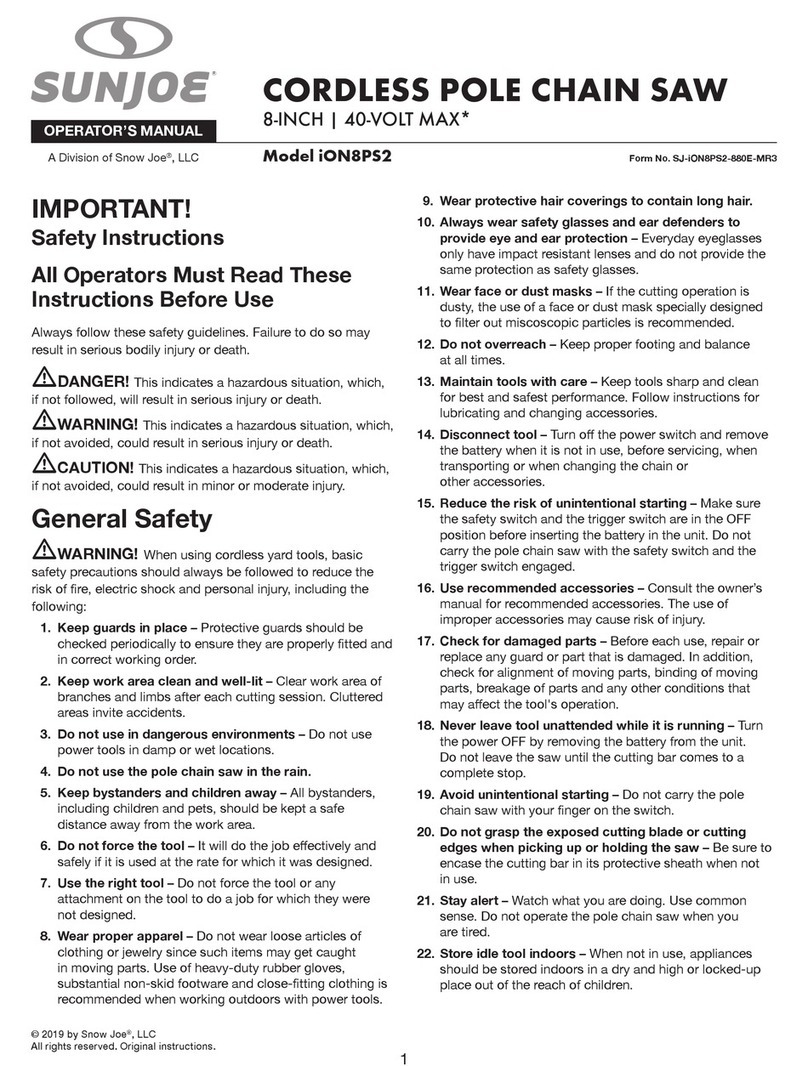
SNOWJOE
SNOWJOE Sunjoe iON8PS2 User manual
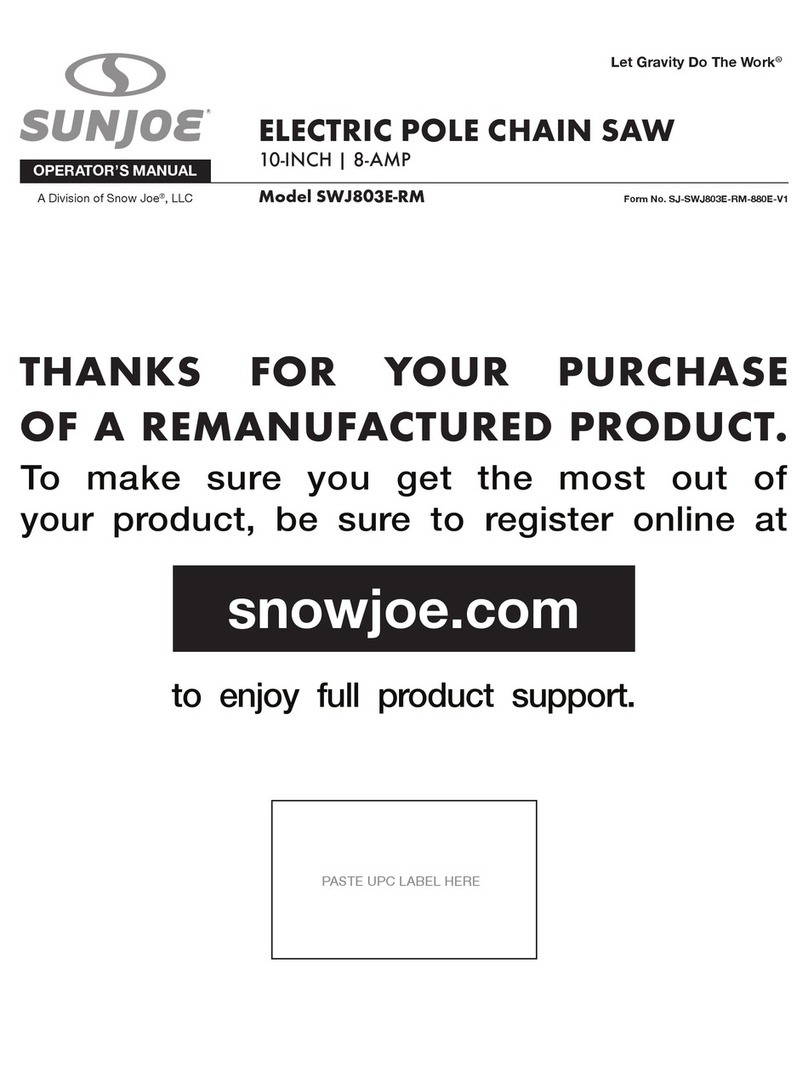
SNOWJOE
SNOWJOE SUNJOE SWJ803E-RM User manual

SNOWJOE
SNOWJOE SUNJOE SWJ806E-HTG User manual
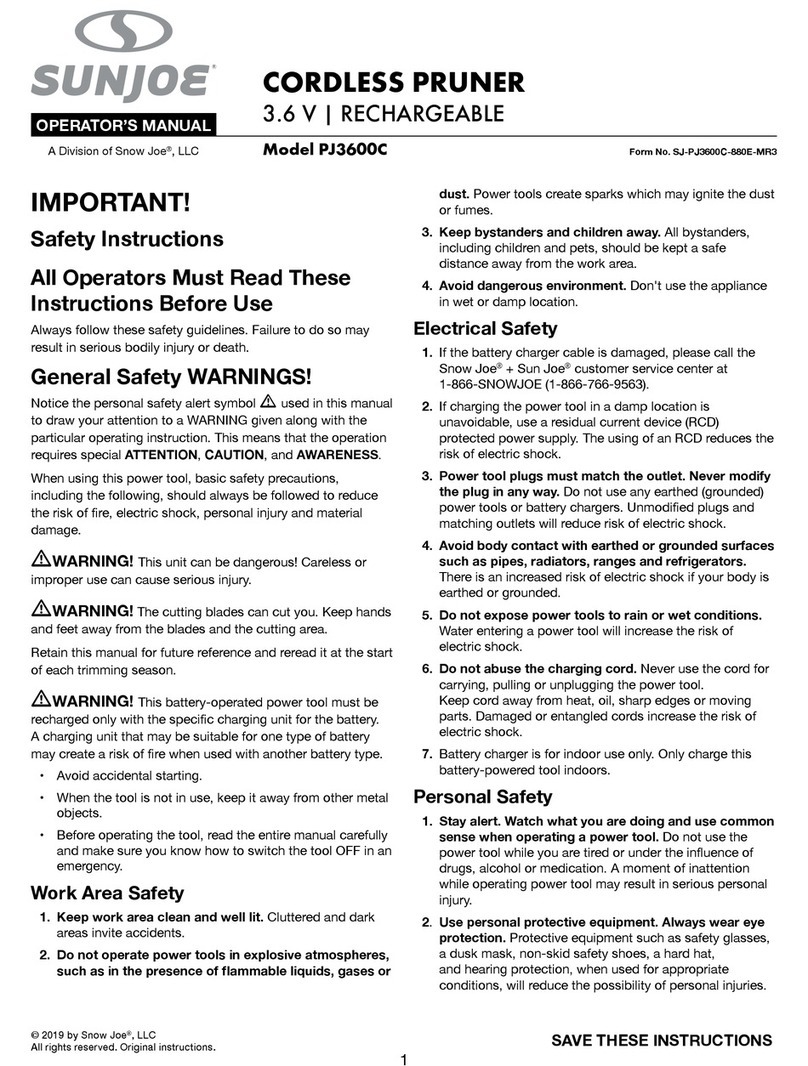
SNOWJOE
SNOWJOE Sunjoe PJ3600C User manual
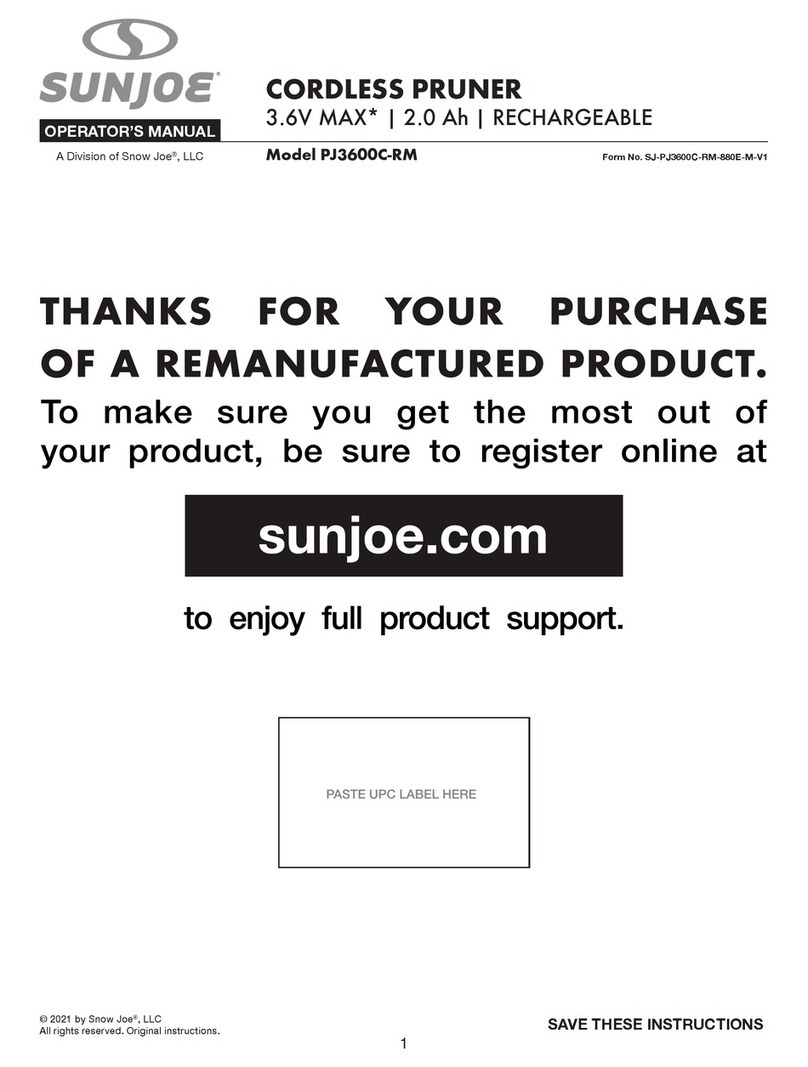
SNOWJOE
SNOWJOE Sunjoe PJ3600C-RM User manual

SNOWJOE
SNOWJOE Sunjoe SWJ801E User manual
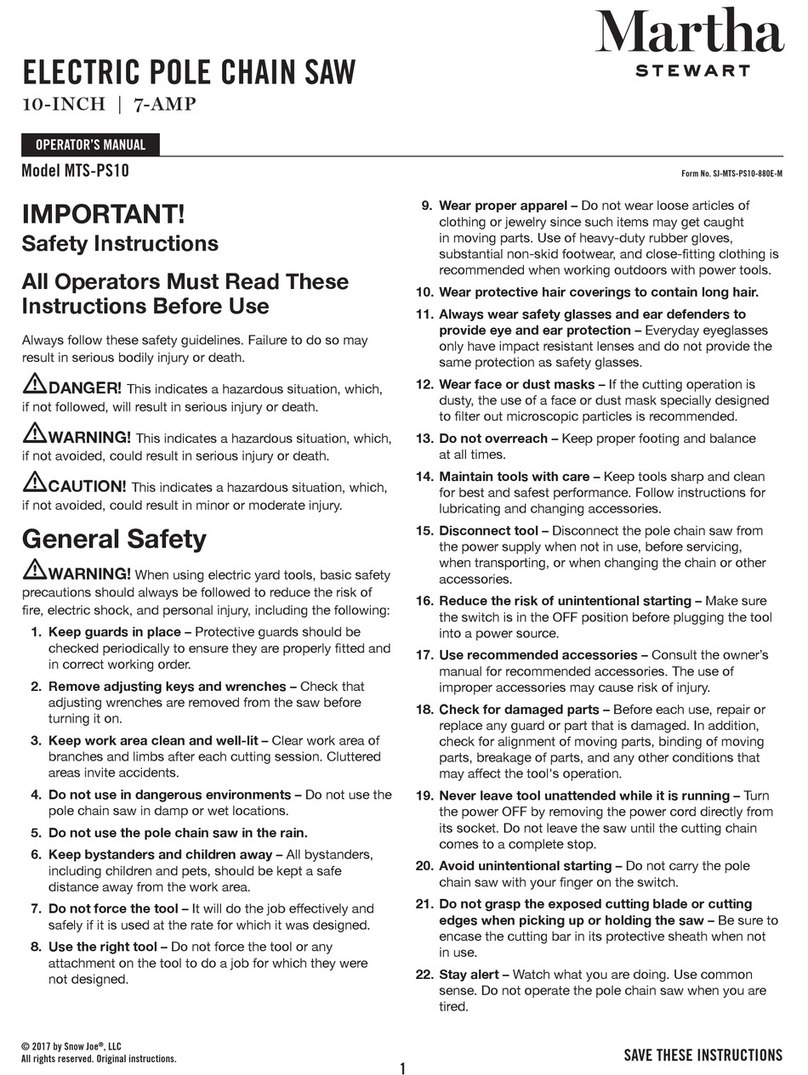
SNOWJOE
SNOWJOE Martha Stewart MTS-PS10 User manual
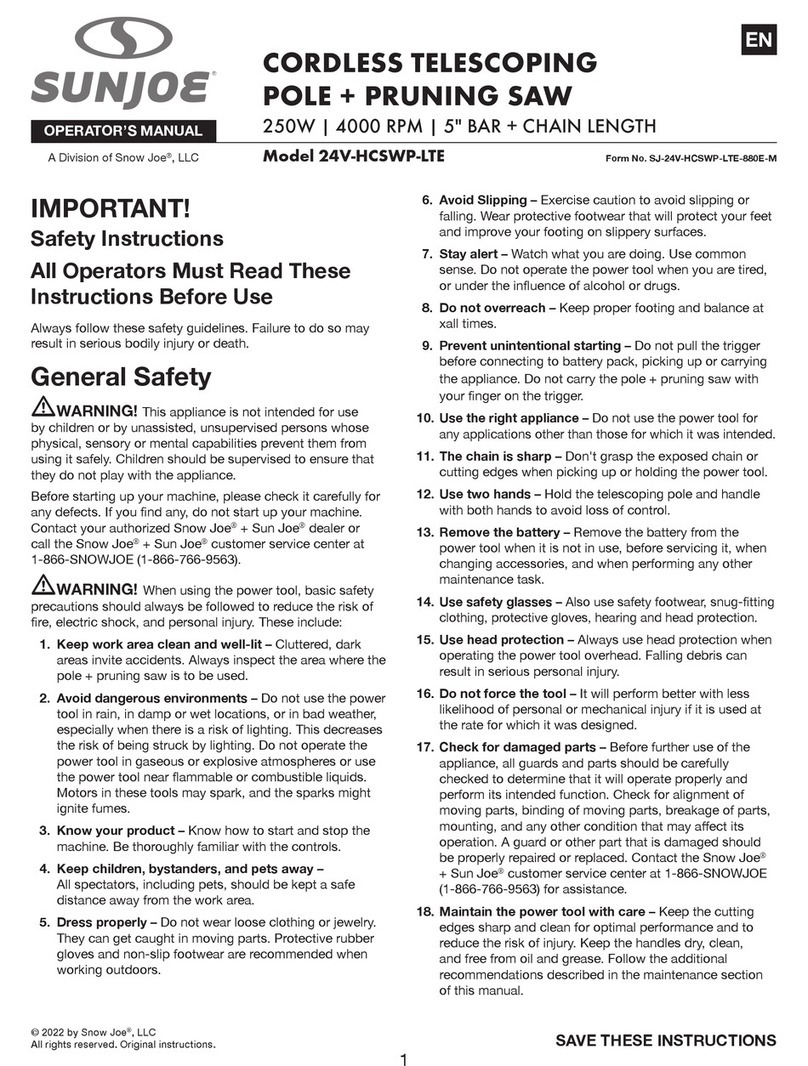
SNOWJOE
SNOWJOE SUNJOE 24V-HCSWP-LTE User manual
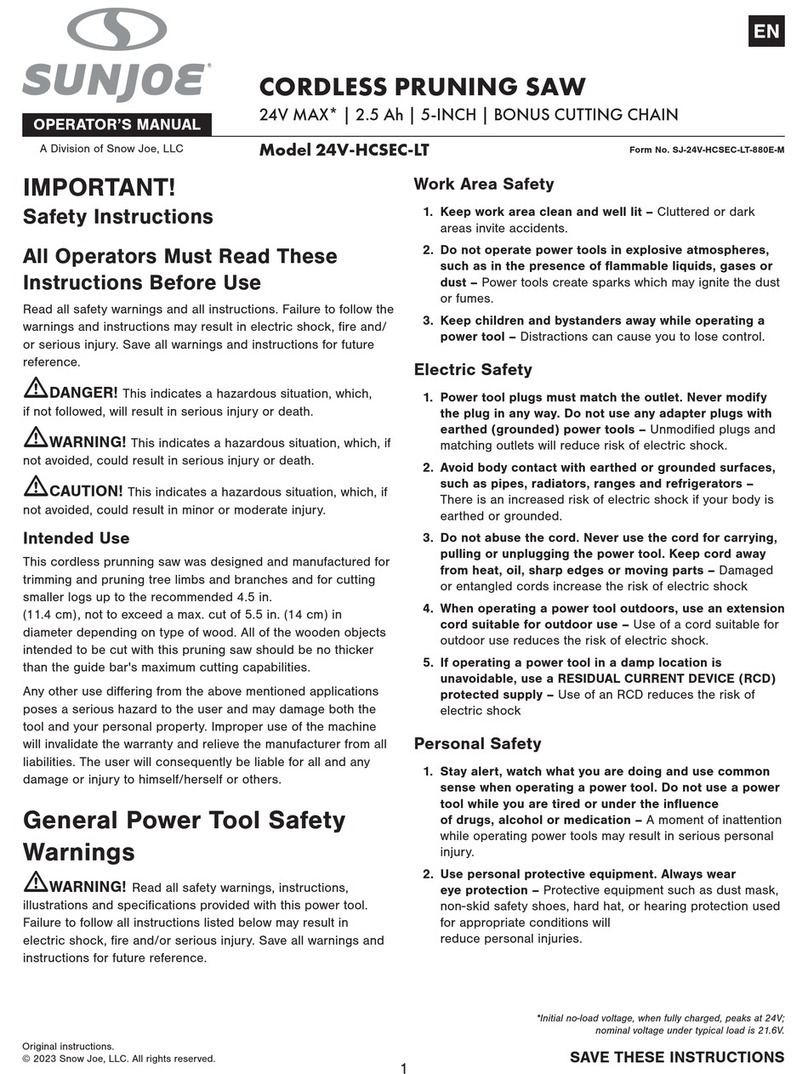
SNOWJOE
SNOWJOE sunjoe 24V-HCSEC-LT User manual
